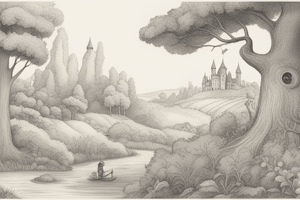Podcast
Questions and Answers
What is the main function of the lungs?
What is the main function of the lungs?
- Filtering toxins from the blood.
- Producing red blood cells.
- Facilitating gas exchange. (correct)
- Pumping blood throughout the body.
Which structure divides into smaller bronchi?
Which structure divides into smaller bronchi?
- Trachea (correct)
- Alveoli
- Bronchiole
- Esophagus
What is the active process of breathing?
What is the active process of breathing?
- Diffusion
- Inspiration (correct)
- Osmosis
- Expiration
Where does gas exchange primarily occur in the lungs?
Where does gas exchange primarily occur in the lungs?
What part of the brain controls breathing?
What part of the brain controls breathing?
What is the function of Type II alveolar cells?
What is the function of Type II alveolar cells?
Which of the following is a chronic inflammatory disease of the airways?
Which of the following is a chronic inflammatory disease of the airways?
How many lobes does the left lung have?
How many lobes does the left lung have?
What is the name of the air sacs or 'functional units' of the lungs?
What is the name of the air sacs or 'functional units' of the lungs?
What is the purpose of the pleura?
What is the purpose of the pleura?
Flashcards
Lungs
Lungs
The primary organs in the respiratory system responsible for gas exchange, transferring oxygen into the bloodstream and removing carbon dioxide.
Alveoli
Alveoli
Air sacs in the lungs where gas exchange between air and blood occurs.
Tidal Volume
Tidal Volume
The amount of air inhaled or exhaled during normal, relaxed breathing.
Gas exchange
Gas exchange
Signup and view all the flashcards
Inspiration (Inhalation)
Inspiration (Inhalation)
Signup and view all the flashcards
Expiration (Exhalation)
Expiration (Exhalation)
Signup and view all the flashcards
Respiratory Center
Respiratory Center
Signup and view all the flashcards
Asthma
Asthma
Signup and view all the flashcards
Pleura
Pleura
Signup and view all the flashcards
Inspiratory Reserve Volume
Inspiratory Reserve Volume
Signup and view all the flashcards
Study Notes
- The lungs are the primary organs of the respiratory system in humans and many other animals
- The main function of the lungs is to facilitate gas exchange, specifically transferring oxygen from the air into the bloodstream and removing carbon dioxide from the bloodstream into the air
- The lungs are located in the chest cavity, enclosed and protected by the rib cage
- The right lung is divided into three lobes (superior, middle, and inferior), while the left lung is divided into two lobes (superior and inferior) to accommodate the heart
- The lungs are spongy and elastic, allowing them to inflate and deflate during breathing
- The pleura, a double-layered membrane, surrounds each lung, providing lubrication and creating a pressure gradient that aids in breathing
Lung Anatomy
- The trachea (windpipe) carries air into the chest cavity, where it divides into the left and right main bronchi
- Each bronchus enters a lung and branches into smaller bronchi, then into bronchioles
- Bronchioles lead to tiny air sacs called alveoli, which are the functional units of the lungs
- There are approximately 300 to 500 million alveoli in the human lungs, providing a large surface area for gas exchange (around 70 square meters)
- The alveolar walls are very thin and are surrounded by a dense network of capillaries, facilitating the diffusion of oxygen and carbon dioxide
- Type I alveolar cells form the structure of the alveolar wall, and Type II alveolar cells secrete surfactant to reduce surface tension and prevent alveolar collapse
Breathing Mechanism
- Breathing involves two main phases: inspiration (inhalation) and expiration (exhalation)
- Inspiration is an active process
- The diaphragm contracts and flattens, while the intercostal muscles contract to raise the rib cage
- These actions increase the volume of the chest cavity, reducing the pressure inside the lungs (intra-pulmonary pressure) below atmospheric pressure, causing air to flow into the lungs
- Expiration is typically a passive process
- The diaphragm and intercostal muscles relax, decreasing the volume of the chest cavity and increasing the intra-pulmonary pressure above atmospheric pressure, causing air to flow out of the lungs
- Forced expiration, such as during exercise or coughing, involves the active contraction of abdominal and internal intercostal muscles
- Lung volumes and capacities: Tidal volume is the amount of air inhaled or exhaled during normal breathing, inspiratory reserve volume is the additional air that can be forcibly inhaled after a normal inhalation, expiratory reserve volume is the additional air that can be forcibly exhaled after a normal exhalation, and residual volume is the air remaining in the lungs after a forced exhalation
- Vital capacity is the total amount of air that can be forcibly exhaled after a maximal inhalation, and total lung capacity is the total volume of air the lungs can hold
Gas Exchange
- Gas exchange occurs in the alveoli
- Oxygen diffuses from the air in the alveoli across the alveolar and capillary walls into the blood, where it binds to hemoglobin in red blood cells
- Carbon dioxide diffuses from the blood into the alveoli to be exhaled
- The efficiency of gas exchange depends on the large surface area of the alveoli, the thinness of the alveolar and capillary walls, and the pressure gradients of oxygen and carbon dioxide
- Partial Pressure: Oxygen moves from an area of high partial pressure (alveoli) to an area of low partial pressure (capillaries)
- Partial Pressure: Carbon dioxide moves from an area of high partial pressure (capillaries) to an area of low partial pressure (alveoli)
Regulation of Breathing
- Breathing is primarily controlled by the respiratory center in the brainstem (medulla oblongata and pons)
- The respiratory center regulates the rate and depth of breathing based on input from chemoreceptors that monitor blood levels of carbon dioxide, oxygen, and pH
- High carbon dioxide levels or low pH (acidity) in the blood stimulate the respiratory center to increase the rate and depth of breathing, to remove carbon dioxide and raise pH
- Low oxygen levels stimulate breathing, but to a lesser extent than carbon dioxide or pH
- The cerebral cortex can exert voluntary control over breathing, such as during speech or breath-holding, but this control is limited
- Hering-Breuer reflex prevents over-inflation of the lungs
Lung Function
- Oxygenating blood by bringing oxygen into the bloodstream
- Removing carbon dioxide from the bloodstream
- Regulating blood pH by adjusting carbon dioxide levels
- Filtering small blood clots from the bloodstream
- Assisting in speech by providing airflow for vocalization
Common Lung Diseases
- Asthma is a chronic inflammatory disease of the airways, causing narrowing and difficulty breathing
- Chronic obstructive pulmonary disease (COPD) is a group of lung diseases, including emphysema and chronic bronchitis, that obstruct airflow and make breathing difficult
- Pneumonia is an infection of the lungs that causes inflammation and fluid buildup in the alveoli
- Lung cancer is a malignant tumor in the lungs, often caused by smoking
- Cystic fibrosis is a genetic disorder that causes thick mucus to build up in the lungs, leading to chronic infections and breathing difficulties
- Pulmonary fibrosis is a condition characterized by the thickening and scarring of lung tissue, making it difficult to breathe
Studying That Suits You
Use AI to generate personalized quizzes and flashcards to suit your learning preferences.





